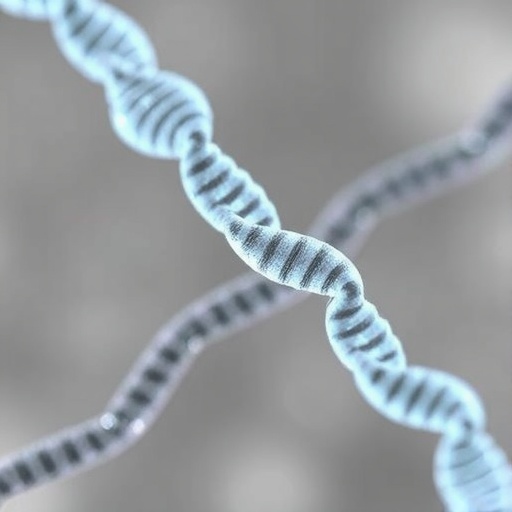In a groundbreaking study recently published in the International Journal of Legal Medicine, researchers have unveiled a powerful new approach for individual identification and kinship testing using nuclear DNA extracted from hair shafts. This innovative method leverages short amplicon strategies combined with advanced bioinformatics modeling to overcome longstanding challenges in forensic genetics. The implications of this research resonate deeply within the forensic science community, heralding transformative possibilities for criminal investigations, missing persons cases, and ancestry verification.
Traditional forensic DNA analysis generally relies heavily on biological materials such as blood, saliva, or tissue, where high-quality nuclear DNA is more readily available. However, hair shafts, the visible part of hair usually found at crime scenes, have historically posed significant obstacles due to their low nuclear DNA content and degradation after environmental exposure. The new study addresses these issues by optimizing amplification processes to target extremely short DNA fragments known as short amplicons.
This focus on short amplicons is of critical importance because hair shaft DNA frequently undergoes fragmentation. Longer DNA segments are often broken down, making conventional genotyping unreliable or impossible when analyzing hair shafts alone. The researchers designed their PCR (polymerase chain reaction) primers and multiplex systems to amplify DNA fragments often shorter than 150 base pairs, enhancing the chances of capturing surviving nuclear DNA material even in compromised samples.
Complementing the laboratory methodology is a sophisticated bioinformatics framework that integrates the resulting genetic data to infer individual identities and close familial relationships. Given the limited and sometimes partial genetic profiles derived from degraded hair shaft DNA, standard forensic algorithms struggle to deliver conclusive results. The computational models developed here weave together probabilistic assessments, population genetics, and machine learning techniques to robustly predict kinship even with minimal genetic input.
The study’s validation was conducted on a broad set of hair samples, including those from individuals with varying hair colors, treatments, and environmental histories. Impressively, the combination of short amplicon PCR and computational analytics yielded reliable nuclear DNA profiles from hair shafts previously deemed unsuitable for forensic testing. This breakthrough expands the utility of hair as a genetic resource beyond current standards that often restrict hair-based forensic analysis to mitochondrial DNA, which has lower discriminatory power for individual identification.
One of the most impactful applications of this research lies in forensic casework. Hair evidence is commonly recovered at crime scenes but is often underutilized because of the technical challenges in obtaining nuclear DNA profiles. With the capability to extract and analyze viable nuclear DNA from hair shafts, forensic laboratories can revisit cold cases where hairs were collected but not analyzed, revitalizing investigative leads that had stalled due to the lack of informative DNA data.
Moreover, kinship testing using nuclear DNA from hair shafts offers remarkable benefits for humanitarian efforts. In disaster victim identification or missing person situations, where conventional biological samples might be scarce or compromised, hair shafts may constitute the only remaining biological evidence. The enhanced testing method enables more definitive connections between unidentified remains and living relatives, expediting resolution and closure in emotionally distressing circumstances.
The researchers also underscore the importance of their protocol’s adaptability to forensic workflows. Short amplicon PCR and bioinformatics pipelines can be integrated into existing laboratory infrastructures without the need for prohibitively expensive equipment upgrades. This cost-effectiveness makes the approach accessible to both well-equipped metropolitan forensic units and smaller regional centers, democratizing access to advanced genetic identification technologies.
A particularly novel element of the work is the robust bioinformatics modeling tailored explicitly for low-template DNA profiles typical of hair shafts. Traditional software packages designed for high-quality DNA often fail or misinterpret partial profiles, resulting in reduced accuracy and higher rates of inconclusive results. By contrast, the models developed here accommodate the unique challenges presented by sparse genetic signals and incorporate population-specific allele frequency databases to refine match probabilities.
Additionally, the research presents an intriguing insight into how certain hair treatments, such as bleaching or dyeing, affect nuclear DNA integrity. The data reveals that although these cosmetic procedures can degrade DNA to some extent, the short amplicon approach is resilient enough to retrieve sufficient genetic information for forensic purposes. This resilience suggests that even aesthetically altered hair samples retain forensic value, potentially expanding the range of hair evidence amenable to nuclear DNA analysis.
Ethical considerations are also addressed, especially regarding privacy and the potential misuse of forensic genetics in kinship prediction. The authors advocate for stringent data handling protocols and transparent consent practices to ensure that advancements in genetic forensic tools do not compromise individual rights or lead to discriminatory outcomes. This balanced perspective highlights the societal responsibility embedded in adopting new biotechnologies within forensic science.
The study’s success has already sparked conversations about the future of forensic DNA databases. Incorporating nuclear DNA profiles derived from hair shafts could dramatically enlarge reference repositories, enabling more comprehensive cross-referencing of genetic data collected from crime scenes or familial databases. Such expansion would likely strengthen the identification power of forensic databases while maintaining data fidelity through advanced modeling techniques.
Looking ahead, the authors suggest further exploration into combining short amplicon nuclear DNA analysis with emerging techniques such as nanopore sequencing and single-cell genomics. These technologies could amplify the resolution and accuracy of forensic identification even more, opening the door to near-complete genetic reconstructions from minute hair samples. The integration of multi-modal genetic analyses represents an exciting frontier in forensic science driven by this study’s foundational work.
In conclusion, this pioneering research stands to revolutionize forensic genetics by unlocking the latent potential of hair shafts for individual and kinship identification. By focusing on short amplicons and leveraging powerful bioinformatics models, the study overcomes historical barriers that have limited the forensic utility of hair-derived nuclear DNA. As forensic laboratories adopt these methodologies, a new era of more precise, sensitive, and inclusive genetic testing in law enforcement and humanitarian contexts appears imminent.
The implications extend beyond the forensic domain, stirring interest among population geneticists, anthropologists, and even genealogical researchers who seek reliable genetic data from non-invasive sources like hair. This cross-disciplinary impact underscores the broad reach and transformative power of the methodology. As the field embraces these advancements, the humble hair shaft may soon become a central piece in the complex puzzle of human identification and kinship analysis worldwide.
Ultimately, the research highlighted in the International Journal of Legal Medicine serves as a testament to how a confluence of molecular biology innovation and computational prowess can push the boundaries of what is achievable in forensic science. By mining the genetic clues locked within hair shafts, we step closer to more effective justice delivery, enhanced humanitarian aid, and deeper insight into human genetic relationships.
Subject of Research: Forensic genetics focusing on individual identification and kinship testing using nuclear DNA extracted from hair shafts through short amplicon PCR and bioinformatics modeling.
Article Title: Individual identification and kinship testing from hair shaft nuclear DNA: leveraging short amplicon strategy and bioinformatics models.
Article References:
Li, R., Wang, N., Dai, S. et al. Individual identification and kinship testing from hair shaft nuclear DNA: leveraging short amplicon strategy and bioinformatics models. Int J Legal Med (2025). https://doi.org/10.1007/s00414-025-03651-7
Image Credits: AI Generated
DOI: https://doi.org/10.1007/s00414-025-03651-7
Tags: amplification processes in DNA testingancestry verification techniquesbioinformatics in DNA analysischallenges in hair DNA identificationforensic genetics advancementsHair shaft DNA analysisimplications for criminal investigationskinship testing in forensicsmissing persons DNA testingnuclear DNA extraction from hairPCR methods for degraded samplesshort amplicon strategies





